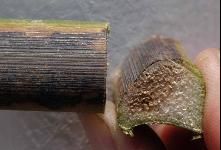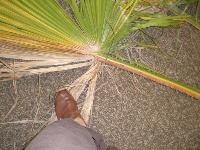BY CHUCK MALLOY and Palm Society of South Texas member
When you drive into the Rio Grande Valley on the Texas Tropical Trail, what’s the first thing that makes you think that it’s tropical? The palm trees! Not just any palms, but the Washingtonia robustas (Mexican Fan Palm).
Back in the 80s the Valley was cursed with palm decline and a hard freeze that almost eliminated the Washingtonias and date palms.
This virtually changed the landscape. We now face a new threat to the Washingtonias and queen palms (Cocos plumosas or Syagrus romanzoffiana), by a fungi known as Fusarium Wilt, (Fusarium oxysporum f.sp. palmarum). There is no cure at this time! Florida was the first and now Houston and Galveston, to get hit with this fungus/pathogen.
The fungus is located in the xylem tissue and blocks water transportation into the frond. It has an interesting characteristic though. It blocks the nutrients on only one side of the frond from the petiole through the fan/pinnate end of the frond.
One side of the frond turns yellow to reddish-brown initially, and then the whole frond dies. Usually the lower fronds are first to die.
Then it moves up into the canopy and the center leaf-shoot is the last to die. In three months the entire palm is dead.
Since the palm dies so fast none of the fronds have time to drop off or even droop. The result is a completely dead tree with its brown fronds intact.
Once the fungus is detected and confirmed, the only course to eliminate the spread of the fungus is to cut down the entire palm — including the stump — and dispose of both.
Do not mulch any part of the palm.
To avoid contamination, do not plant other susceptible palms in the same place because once the fungus starts it has a domino effect. It is not known to exist here in the RGV yet, but as happens with most diseases, someone will knowingly or unknowingly transport a plant or a piece of equipment and the fungus could become endemic.
The current belief is that wind-borne spores and contaminated tree equipment are the disease transference mechanism.
What can we do to help prevent the spread of this disease? As with any life form, the palm’s best defense is a strong immune system. Make sure your plants are getting proper watering and nutrients to ward off disease.
Also do not over-prune any palm as this weakens the its ability to photosynthesize or build a strong immune system, and makes the tree more susceptible to pathogens. Pruning should always be limited to dead or dying fronds.
The typical over-pruning of palms that one sees in the RGV puts the palms at risk for many diseases and deficiencies.
Palms should have a full crown and not look like a shaving brush. All pruning devices should be sanitized between the trimming of every tree.
SOURCES:
https://edis.ifas.ufl.edu/pp278 Monica L. Elliott, Professor Plant Pathology Dept.
University of Florida IFAS Extension Publication #PP278
Texas A&M AgriLife Extension






